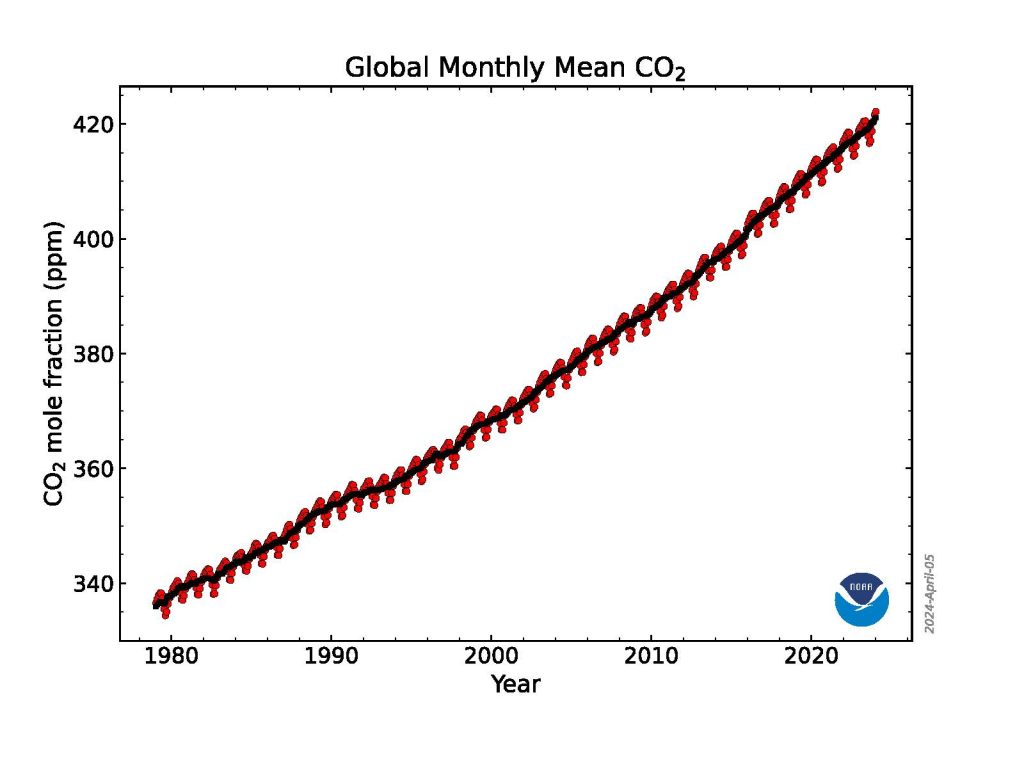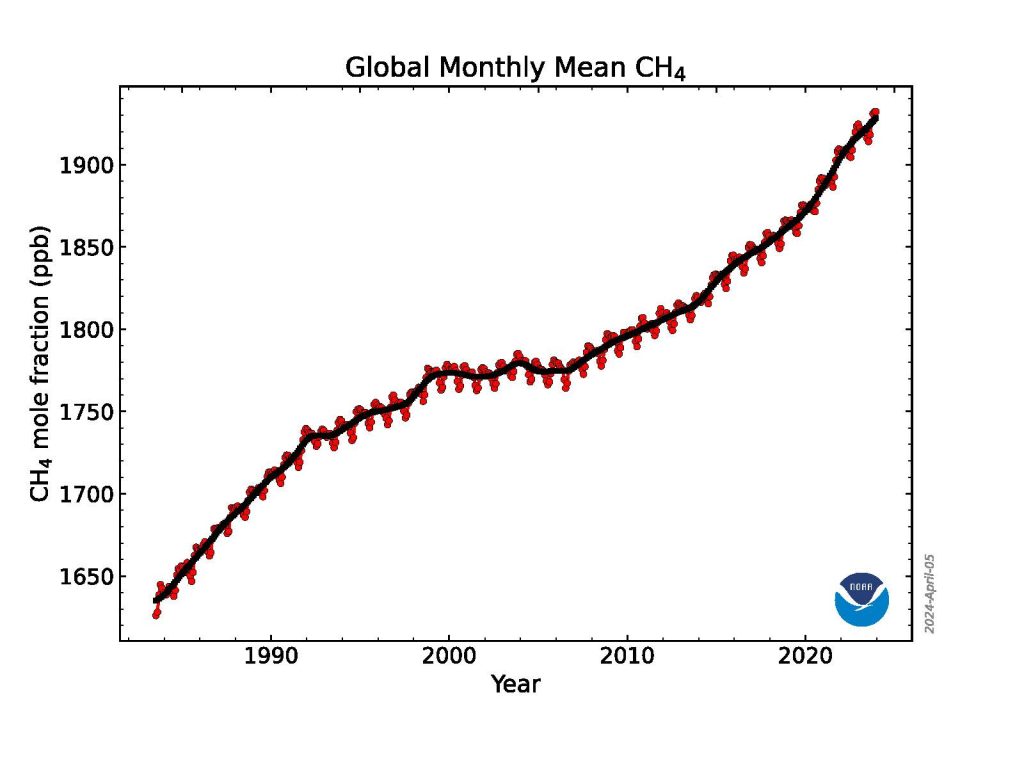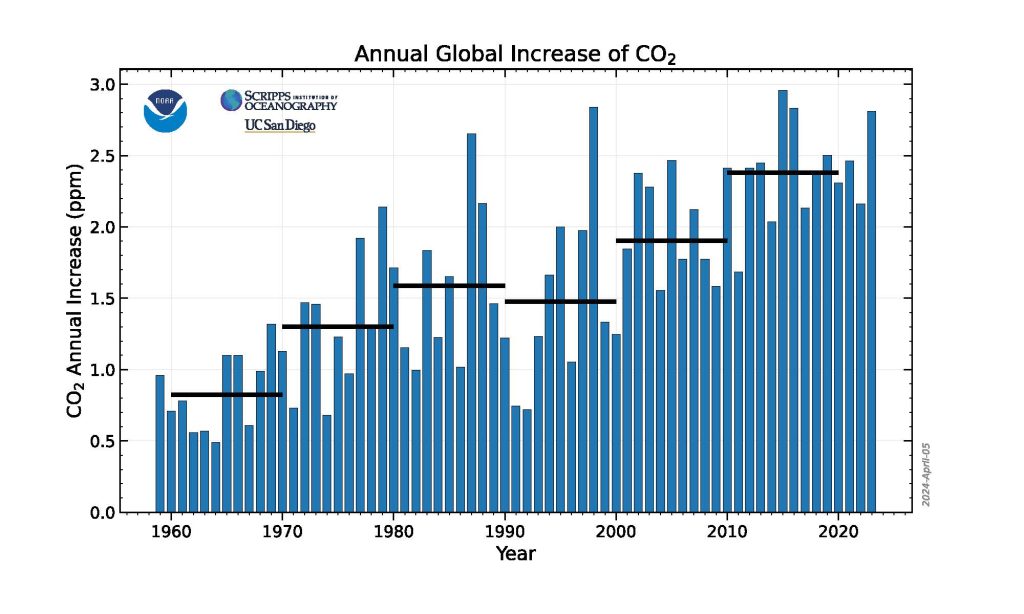No sign of greenhouse gases increases slowing in 2023 – NOAA Research
No sign of greenhouse gases increases slowing in 2023 noaa.gov


Levels of Greenhouse Gases Continue to Rise, Highlighting the Need for Action on Climate Change
The levels of carbon dioxide (CO2), methane, and nitrous oxide, the three most significant human-caused greenhouse gases, have continued to increase steadily in 2023, according to scientists from the National Oceanic and Atmospheric Administration (NOAA).
Tracking Climate Change with NOAA’s Global Monitoring Laboratory
NOAA’s Global Monitoring Laboratory (GML) plays a crucial role in monitoring the causes of climate change and supporting efforts to establish a comprehensive national greenhouse gas measuring, monitoring, and information system in the United States. The air samples collected by GML in 2023 showed that the rise in greenhouse gases was not as high as in recent years but still consistent with the steep increases observed over the past decade.
The data collected by GML is essential for understanding climate change and progress towards achieving the Sustainable Development Goals (SDGs). It highlights the urgent need for action to reduce greenhouse gas emissions and mitigate the impacts of climate change.
Carbon Dioxide Concentration Reaches Record High
The global surface concentration of CO2 averaged 419.3 parts per million (ppm) in 2023, an increase of 2.8 ppm compared to the previous year. This marks the 12th consecutive year of CO2 increases of more than 2 ppm, setting a new record for sustained CO2 growth. The current atmospheric CO2 levels are now over 50% higher than pre-industrial levels.

Methane Levels Remain High
Atmospheric methane, a potent greenhouse gas, reached an average concentration of 1922.6 parts per billion (ppb) in 2023. Although the increase in methane levels was lower than in previous years, it was still the fifth-highest since renewed methane growth started in 2007. Methane concentrations in the atmosphere are now more than 160% higher than pre-industrial levels.

Nitrous Oxide Levels on the Rise
Nitrous oxide, another significant greenhouse gas, increased by 1 ppb to reach a concentration of 336.7 ppb in 2023. The highest growth rates in recent years occurred in 2020 and 2021. The increase in nitrous oxide levels is primarily attributed to the use of nitrogen fertilizer and manure in agriculture. Nitrous oxide concentrations are now 25% higher than pre-industrial levels.
NOAA’s Efforts to Monitor Greenhouse Gases
NOAA’s Global Monitoring Laboratory collected over 15,000 air samples from monitoring stations worldwide in 2023. These samples were analyzed in NOAA’s state-of-the-art laboratory in Boulder, Colorado. The measurements obtained from these samples provide valuable insights into greenhouse gas concentrations, emissions, and carbon cycle feedbacks.
The Global Greenhouse Gas Reference Network, which includes cooperative sampling sites, tall tower sites, and routine aircraft operation sites, plays a crucial role in collecting these air samples and monitoring greenhouse gas levels.
Addressing the Challenge of Carbon Dioxide Emissions
Carbon dioxide emissions from burning fossil fuels remain the most significant contributor to climate change. Human-caused CO2 pollution has increased from 10.9 billion tons per year in the 1960s to approximately 36.6 billion tons per year in 2023. This sets a new record, highlighting the urgent need to reduce carbon emissions and transition to cleaner energy sources.

The current levels of CO2 in the atmosphere are comparable to those during the mid-Pliocene epoch, approximately 4.3 million years ago. This period was characterized by significantly higher sea levels, elevated temperatures, and extensive forests in the Arctic region.
Approximately half of the CO2 emissions from fossil fuels have been absorbed by the Earth’s surface, with oceans and land ecosystems acting as sinks. However, this absorption has led to ocean acidification and other detrimental impacts on marine life.
Understanding the Rise in Methane Levels
Methane emissions have been increasing rapidly since the 1980s, with a temporary stabilization in the late-1990s and early 2000s. The recent rise in methane levels is primarily attributed to increased microbial emissions from various sources, including livestock, agriculture, waste, wetlands, and aquatic environments. NOAA scientists are actively researching the causes of this increase, including the potential role of climate change and feedback loops.
Conclusion
The continuous rise in greenhouse gas levels emphasizes the urgent need for action to address climate change and achieve the Sustainable Development Goals. NOAA’s Global Monitoring Laboratory plays a crucial role in monitoring these gases and providing valuable data for policymakers and researchers. It is essential to reduce greenhouse gas emissions, transition to renewable energy sources, and implement sustainable practices to mitigate the impacts of climate change.
For more
SDGs, Targets, and Indicators
SDGs Addressed:
- SDG 13: Climate Action
Targets Identified:
- Target 13.1: Strengthen resilience and adaptive capacity to climate-related hazards and natural disasters
- Target 13.2: Integrate climate change measures into national policies, strategies, and planning
- Target 13.3: Improve education, awareness-raising, and human and institutional capacity on climate change mitigation, adaptation, impact reduction, and early warning
Indicators Identified:
- Indicator 13.1.1: Number of deaths, missing persons, and directly affected persons attributed to disasters per 100,000 population
- Indicator 13.2.1: Number of countries that have communicated the establishment or operationalization of an integrated policy/strategy/plan which increases their ability to adapt to the adverse impacts of climate change, and foster climate resilience and low greenhouse gas emissions development in a manner that does not threaten food production
- Indicator 13.3.1: Number of countries that have integrated mitigation, adaptation, impact reduction, and early warning into primary, secondary, and tertiary curricula
Analysis:
1. Which SDGs are addressed or connected to the issues highlighted in the article?
The article addresses SDG 13: Climate Action. It discusses the increase in greenhouse gases, such as carbon dioxide (CO2), methane, and nitrous oxide, which are major contributors to climate change.
2. What specific targets under those SDGs can be identified based on the article’s content?
Based on the article’s content, the following targets can be identified:
- Target 13.1: Strengthen resilience and adaptive capacity to climate-related hazards and natural disasters
- Target 13.2: Integrate climate change measures into national policies, strategies, and planning
- Target 13.3: Improve education, awareness-raising, and human and institutional capacity on climate change mitigation, adaptation, impact reduction, and early warning
3. Are there any indicators mentioned or implied in the article that can be used to measure progress towards the identified targets?
Yes, there are indicators mentioned or implied in the article that can be used to measure progress towards the identified targets:
- Indicator 13.1.1: Number of deaths, missing persons, and directly affected persons attributed to disasters per 100,000 population
- Indicator 13.2.1: Number of countries that have communicated the establishment or operationalization of an integrated policy/strategy/plan which increases their ability to adapt to the adverse impacts of climate change, and foster climate resilience and low greenhouse gas emissions development in a manner that does not threaten food production
- Indicator 13.3.1: Number of countries that have integrated mitigation, adaptation, impact reduction, and early warning into primary, secondary, and tertiary curricula
Table: SDGs, Targets, and Indicators
| SDGs | Targets | Indicators |
|---|---|---|
| SDG 13: Climate Action | Target 13.1: Strengthen resilience and adaptive capacity to climate-related hazards and natural disasters | Indicator 13.1.1: Number of deaths, missing persons, and directly affected persons attributed to disasters per 100,000 population |
| SDG 13: Climate Action | Target 13.2: Integrate climate change measures into national policies, strategies, and planning | Indicator 13.2.1: Number of countries that have communicated the establishment or operationalization of an integrated policy/strategy/plan which increases their ability to adapt to the adverse impacts of climate change, and foster climate resilience and low greenhouse gas emissions development in a manner that does not threaten food production |
| SDG 13: Climate Action | Target 13.3: Improve education, awareness-raising, and human and institutional capacity on climate change mitigation, adaptation, impact reduction, and early warning | Indicator 13.3.1: Number of countries that have integrated mitigation, adaptation, impact reduction, and early warning into primary, secondary, and tertiary curricula |
Behold! This splendid article springs forth from the wellspring of knowledge, shaped by a wondrous proprietary AI technology that delved into a vast ocean of data, illuminating the path towards the Sustainable Development Goals. Remember that all rights are reserved by SDG Investors LLC, empowering us to champion progress together.
Source: research.noaa.gov

Join us, as fellow seekers of change, on a transformative journey at https://sdgtalks.ai/welcome, where you can become a member and actively contribute to shaping a brighter future.







